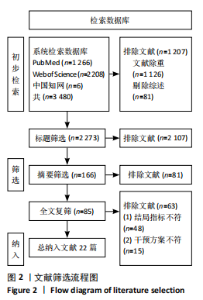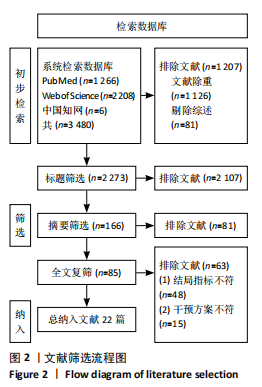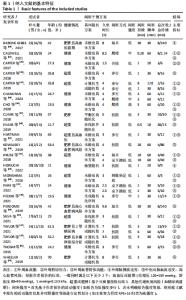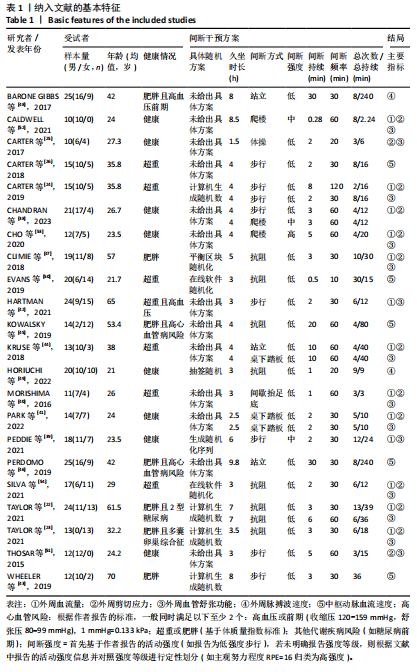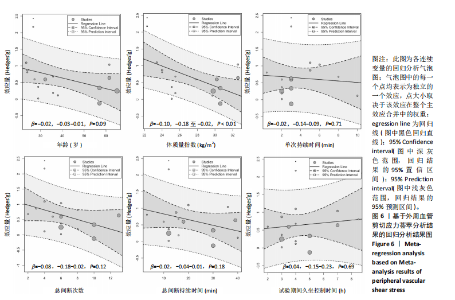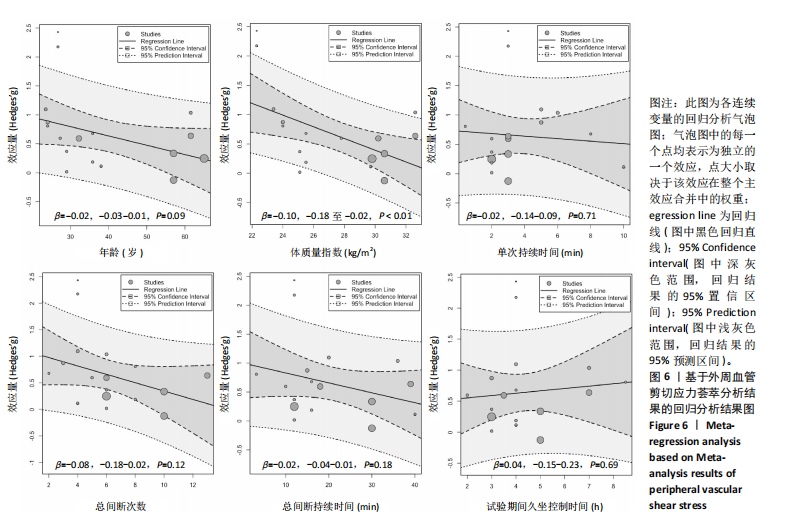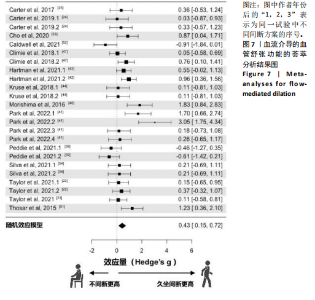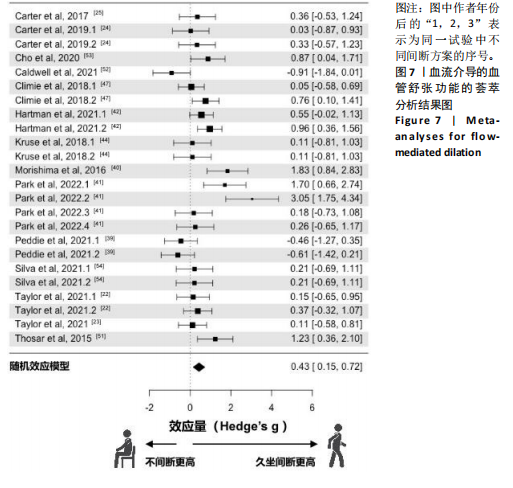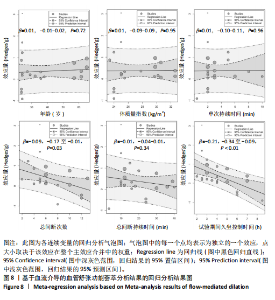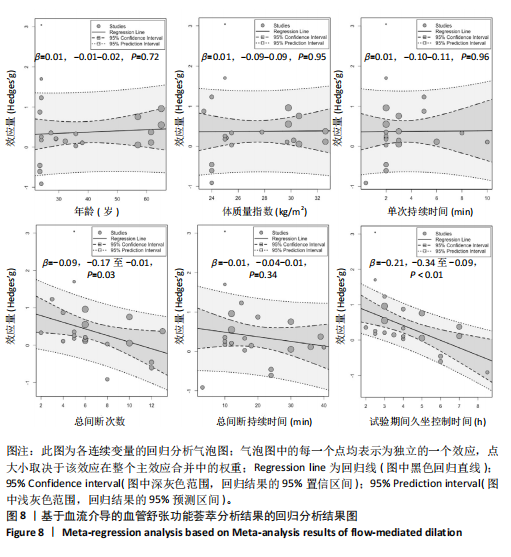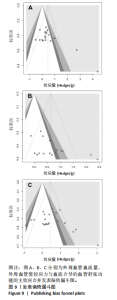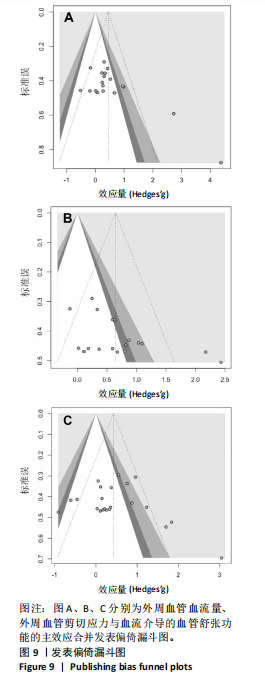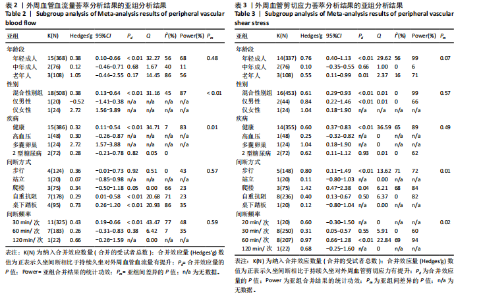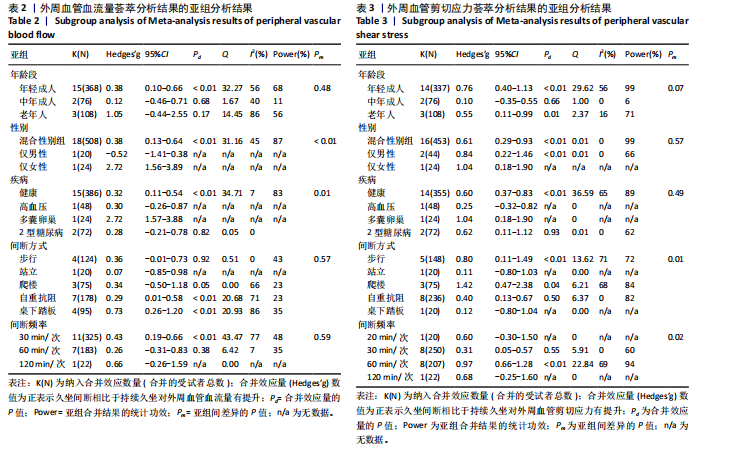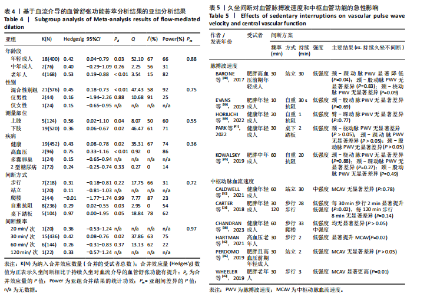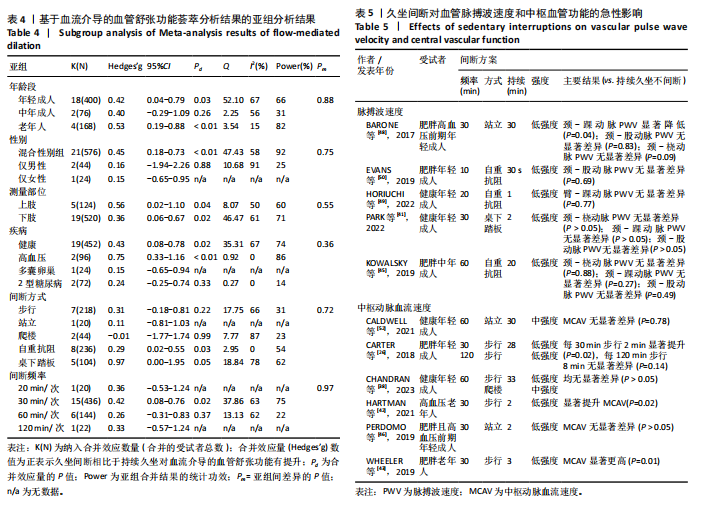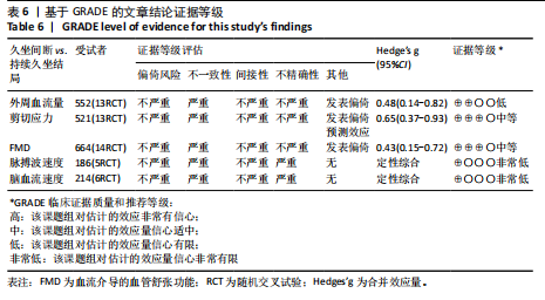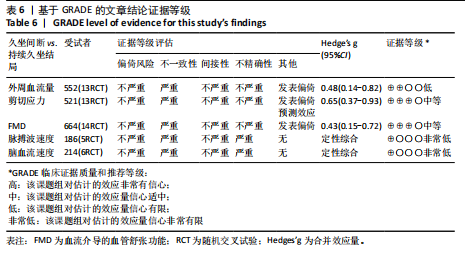Chinese Journal of Tissue Engineering Research ›› 2025, Vol. 29 ›› Issue (17): 3684-3696.doi: 10.12307/2025.627
Previous Articles Next Articles
Acute effects and moderators of sedentary interruption on vascular function in adults: a Meta-analysis
Yin Mingyue1, Liu Qian2, Xu Xiongzhuang2, 3, Ma Zhiying4, Deng Shengji1, 5, Deng Jianfeng1, 5, Li Yongming1, 6
- 1School of Athletic Performance, 4School of Exercise and Health, Shanghai University of Sport, Shanghai 200438, China; 2School of Physical Education, Sichuan Agricultural University, Yaan 625014, Sichuan Province, China; 3Institute of Sport Science, School of Physical Education, Southwest University, Chongqing 400715, China; 5School of Human Science, University of Western Australia, Perth, Australia; 6National Research Institute of Sports Science, Beijing 100061, China
-
Received:2024-06-15Accepted:2024-07-15Online:2025-06-18Published:2024-11-06 -
Contact:Li Yongming, MD, Professor, Doctoral supervisor, School of Athletic Performance, Shanghai University of Sport, Shanghai 200438, China; National Research Institute of Sports Science, Beijing 100061, China -
About author:Yin Mingyue, Master candidate, School of Athletic Performance, Shanghai University of Sport, Shanghai 200438, China
CLC Number:
Cite this article
Yin Mingyue, Liu Qian, Xu Xiongzhuang, Ma Zhiying, Deng Shengji, Deng Jianfeng, Li Yongming. Acute effects and moderators of sedentary interruption on vascular function in adults: a Meta-analysis[J]. Chinese Journal of Tissue Engineering Research, 2025, 29(17): 3684-3696.
share this article
Add to citation manager EndNote|Reference Manager|ProCite|BibTeX|RefWorks
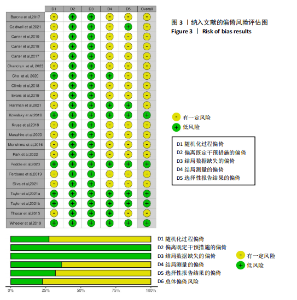
2.2 纳入文献特征 文章共纳入了22篇文献[22-26,38–54],见表1,均为随机交叉试验。共纳入364名受试者(男性204人,56%),单例研究受试者人数为10-25人,年龄为21-70岁,受试者类型为健康(117人,32%)、超重/肥胖(247人,68%)、2型糖尿病(24人,7%)、高血压(49人,13%)和多囊卵巢综合征(13人,4%)。纳入研究对应久坐时长为1.43-9.8 h/d。22篇文献中共含27个久坐间断干预条件,涉及的久坐间断方式包括步行(30%)、抗阻(26%)、站立(16%)、爬楼(10%)、桌下踏板(10%)、健身操(4%)、间歇抬足底(4%),单次间断时间0.28-30 min,间断频率为每20 min、30 min、60 min与120 min。 2.3 文献偏倚风险评估结果 文章纳入试验的偏倚风险集中于随机化过程、结局测量与选择性报告结果,其均可能有一定偏倚风险,见图3。 2.4 Meta分析结果 2.4.1 外周血管血流量 纳入13篇文献(20项效应,552名受试者)荟萃"
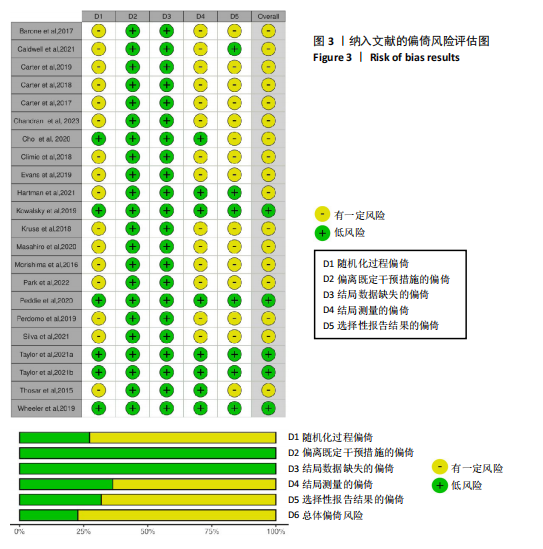
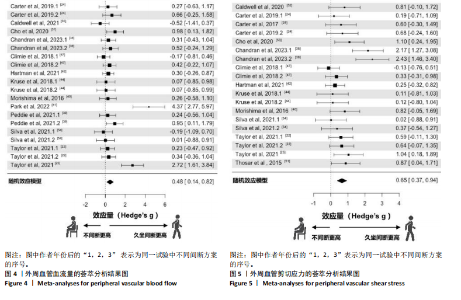
分析发现,久坐间断相比于持续久坐显著提升外周血管血流量(Hedge’s g=0.48,95%CI:0.14-0.82,P < 0.01),且异质性较高,主效应合并结果的统计功效为92%,见图4。敏感性分析显示,合并结果稳定。 亚组分析结果见表2。疾病可能是显著的调节因素(P=0.01):相比于持续久坐,仅观察到久坐间断对健康成人外周血管血流量有显著提升(Hedges’g=0.32,P < 0.01)。未观察到间断方式与间断频率对久坐间断改善外周血管血流量有显著调节作用(P > 0.05)。 对年龄、体质量指数、单次间断持续时长、总间断次数、总间断时长与试验期间久坐控制时长对主效应合并的调节作用进行了回归分析,但未观察到任何显著的调节作用(P > 0.05)。 2.4.2 外周血管剪切应力 纳入13篇文献(19项效应,521名受试者)荟萃分析发现,久坐间断相比于持续久坐显著提升外周血管剪切应力(Hedge’s g=0.65,95%CI:0.37-0.94,P < 0.01),且异质性较高,主效应合并结果的统计功效为99%,见图5。敏感性分析显示,合并结果稳定。 亚组分析结果见表3,间断方式与间断频率可能是显著的调节因素,没有观察到疾病对久坐间断改善外周血管剪切应力有显著调节作用(P > 0.05)。 回归分析结果见图6,久坐间断改善外周血管剪切应力受到受试者年龄与体质量影响。未发现其他因素(单次间断持续时长、总间断次数、总间断时长、试验期间久坐控制时长)对久坐间断改善外周血管剪切应力效果存在影响。 2.4.3 血流介导的血管舒张功能 纳入14篇文献(24项效应,644名受试者)荟萃分析发现,久坐间断相比于持续久坐显著提升FMD(Hedge’s g=0.43,95%CI:0.15-0.72,P < 0.01),且异质性较高,主效应合并结果的统计功效为92%,见图7。敏感性分析显示,合并结果稳定。 亚组分析结果见表4,未观察到疾病、间断方式与间断频率对久坐间断改善FMD有显著的调节作用(P > 0.05)。 回归分析结果显示,久坐间断改善FMD受到总间断次数与试验期间久坐控制时长影响,更多的总间断次数并不会带来更大幅度的FMD增加,试验期间更长的久坐持续时间将反向衰减久坐间断对FMD的改善益处,每增加1 h久坐时长与久坐间断改善FMD的幅度减弱0.67%相关。未发现其他因素(年龄、体质量指数、单次间断持续时长、总间断时长)对久坐间断改善FMD效果存在影响,见图8。 2.4.4 血管脉搏波速度 目前纳入原始试验较一致的发现久坐间断对血管脉搏波速度无急性显著影响,见表5。 2.4.5 中枢血管功能 目前纳入原始试验较一致的发现久坐间断对健康至肥胖的年轻成人的中枢血管功能无急性显著影响,见表5。然而,发现久坐间断显著提升了肥胖或高血压老年人的中枢动脉血流速度。"
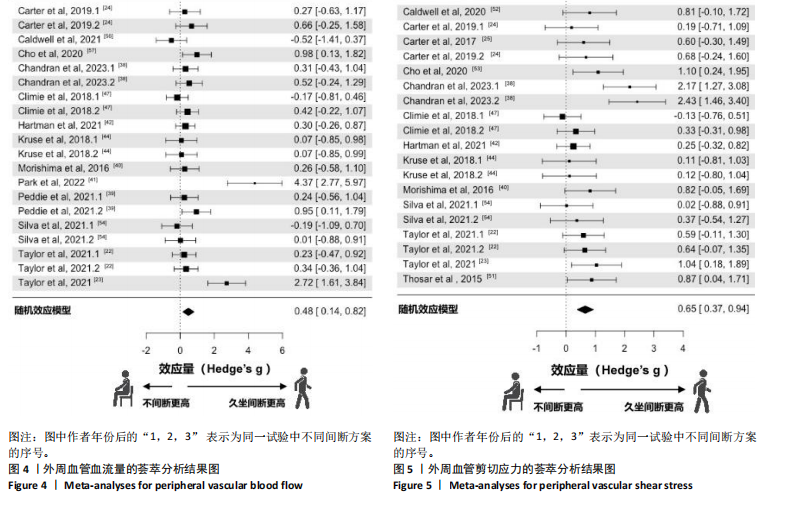
| [1] TREMBLAY MS, AUBERT S, BARNES JD, et al. Sedentary behavior research network (SBRN) -Terminology consensus project process and outcome. Int J Behav Nutr Phys Act. 2017;14(1):75-92. [2] YANG L, CAO C, KANTOR ED, et al. Trends in sedentary behavior among the US population, 2001-2016. JAMA. 2019; 321(16):1587-1597. [3] CHEN Y, CHAN S, BENNETT D, et al. Device-measured movement behaviours in over 20,000 China Kadoorie Biobank participants. Int J Behav Nutr Phys Act. 2023;20(1):138-149. [4] EKELUND U, STEENE-JOHANNESSEN J, BROWN WJ, et al. Does physical activity attenuate, or even eliminate, the detrimental association of sitting time with mortality? A harmonised meta-analysis of data from more than 1 million men and women. Lancet. 2016;388(10051): 1302-1310. [5] DUNSTAN DW, DOGRA S, CARTER SE, et al. Sit less and move more for cardiovascular health: emerging insights and opportunities. Nat Rev Cardiol. 2021;18(9):637-648. [6] PANDEY A, SALAHUDDIN U, GARG S, et al. Continuous dose-response association between sedentary time and risk for cardiovascular disease: a meta-analysis. JAMA Cardiol. 2016;1(5):575-583.
[7] GREEN DJ, JONES H, THIJSSEN D, et al. Flow-mediated dilation and cardiovascular event prediction: does nitric oxide matter? Hypertension. 2011;57(3):363-369. [8] INABA Y, CHEN JA, BERGMANN SR. Prediction of future cardiovascular outcomes by flow-mediated vasodilatation of brachial artery: a meta-analysis. Int J Cardiovasc Imaging. 2010;26(6):631-640. [9] PINTO AJ, BERGOUIGNAN A, DEMPSEY PC, et al. Physiology of sedentary behavior. Physiol Rev. 2023;103(4):2561-2622. [10] PATERSON C, FRYER S, ZIEFF G, et al. The effects of acute exposure to prolonged sitting, with and without interruption, on vascular function among adults: a meta-analysis. Sports Med. 2020;50(11):1929-1942. [11] WONG ND, SATTAR N. Cardiovascular risk in diabetes mellitus: epidemiology, assessment and prevention. Nat Rev Cardiol. 2023;20(10):685-695. [12] PADILLA J, FADEL PJ. Prolonged sitting leg vasculopathy: contributing factors and clinical implications. Am J Physiol Heart Circ Physiol. 2017;313(4):H722-H728. [13] 顾东风,翁建平,鲁向锋.中国健康生活方式预防心血管代谢疾病指南[J].中国循环杂志,2020,35(3):209-230. [14] ZHENG C, ZHANG X, SHERIDAN S, et al. Effect of sedentary behavior interventions on vascular function in adults: a systematic review and meta-analysis. Scand J Med Sci Sports. 2021;31(7):1395-1410. [15] SOTO-RODRÍGUEZ FJ, CABAÑAS EI, PÉREZ-MÁRMOL JM. Impact of prolonged sitting interruption strategies on shear rate, flow-mediated dilation and blood flow in adults: a systematic review and meta-analysis of randomized cross-over trials. J Sports Sci. 2022;40(14):1558-1567. [16] TAYLOR FC, PINTO AJ, MANIAR N, et al. The acute effects of prolonged uninterrupted sitting on vascular function: a systematic review and meta-analysis. Med Sci Sports Exerc. 2022;54(1):67-76. [17] 祝莉,王正珍,朱为模.健康中国视域中的运动处方库构建[J].体育科学,2020, 40(1):4-15. [18] 卢文云,陈佩杰.全民健身与全民健康深度融合的内涵、路径与体制机制研究[J].体育科学,2018,38(5):25-39, 55. [19] 健康中国行动(2019-2030年):总体要求、重大行动及主要指标[J].中国循环杂志, 2019,34(9):846-858. [20] PAGE MJ, MCKENZIE JE, BOSSUYT PM, et al. The PRISMA 2020 statement: an updated guideline for reporting systematic reviews. BMJ. 2021;29;372:n71. [21] CUMPSTON M, LI T, PAGE MJ, et al. Updated guidance for trusted systematic reviews: a new edition of the cochrane handbook for systematic reviews of interventions. Cochrane Database Syst Rev. 2019;10:ED000142. [22] TAYLOR FC, DUNSTAN DW, HOMER AR, et al. Acute effects of interrupting prolonged sitting on vascular function in type 2 diabetes. Am J Physiol Heart Circ Physiol. 2021;320(1):H393-h403. [23] TAYLOR FC, DUNSTAN DW, FLETCHER E, et al. Interrupting prolonged sitting and endothelial function in polycystic ovary syndrome. Med Sci Sports Exerc. 2021;53(3):479-486. [24] CARTER SE, DRAIJER R, HOLDER SM, et al. Effect of different walking break strategies on superficial femoral artery endothelial function. Physiol Rep. 2019;7(16):e14190. [25] CARTER SE, GLADWELL VF. Effect of breaking up sedentary time with callisthenics on endothelial function. J Sports Sci. 2017; 35(15):1508-1514. [26] CARTER SE, DRAIJER R, HOLDER SM, et al. Regular walking breaks prevent the decline in cerebral blood flow associated with prolonged sitting. J Appl Physiol (1985). 2018;125(3):790-798. [27] HIGGINS JPT, ALTMAN DG, GØTZSCHE PC, et al. The Cochrane Collaboration’s tool for assessing risk of bias in randomised trials. BMJ. 2011;343:d5928. [28] DERSIMONIAN R, LAIRD N. Meta-analysis in clinical trials. Controlled Clinical Trials. 1986;7(3):177-188. [29] NAGASHIMA K, NOMA H, FURUKAWA TA. Prediction intervals for random-effects meta-analysis: a confidence distribution approach. Stat Methods Med Res. 2019; 28(6):1689-1702. [30] COHEN J. Statistical power analysis for the behavioral sciences. 2nd edition. New York: Routledge, USA. 1988. [31] ABT G, BOREHAM C, DAVISON G, et al. Power, precision, and sample size estimation in sport and exercise science research. J Sports Sci. 2020;38(17):1933-1935. [32] NAKAGAWA S, NOBLE DWA, SENIOR AM, et al. Meta-evaluation of meta-analysis: ten appraisal questions for biologists. BMC Biol. 2017;15(1):18. [33] BINNEY ZO, MANSOURNIA MA. Methods matter: (mostly) avoid categorising continuous data - a practical guide. Br J Sports Med. 2024;58(5):241-243. [34] RICO-GONZÁLEZ M, PINO-ORTEGA J, CLEMENTE F, et al. Guidelines for performing systematic reviews in sports science. Biol Sport. 2022;39(2):463-471. [35] PETERS JL, SUTTON AJ, JONES DR, et al. Contour-enhanced meta-analysis funnel plots help distinguish publication bias from other causes of asymmetry. J Clin Epidemiol. 2008;61(10):991-996. [36] EGGER M, DAVEY SMITH G, SCHNEIDER M, et al. Bias in meta-analysis detected by a simple, graphical test. BMJ. 1997; 315(7109):629-634. [37] GUYATT GH, OXMAN AD, VIST GE, et al. GRADE: an emerging consensus on rating quality of evidence and strength of recommendations. BMJ. 2008;336(7650): 924-926. [38] CHANDRAN O, SHRUTHI P, SUKUMAR S, et al. Effects of physical activity breaks during prolonged sitting on vascular and executive function-A randomised cross-over trial. J Taibah Univ Med Sci. 2023;18(5):1065-1075. [39] PEDDIE MC, KESSELL C, BERGEN T, et al. The effects of prolonged sitting, prolonged standing, and activity breaks on vascular function, and postprandial glucose and insulin responses: a randomised crossover trial. PLoS One. 2021;16(1):e0244841. [40] MORISHIMA T, RESTAINO RM, WALSH LK, et al. Prolonged sitting-induced leg endothelial dysfunction is prevented by fidgeting. Am J Physiol Heart Circ Physiol. 2016;311(1):H177-182. [41] PARK SY, WOODEN TK, PEKAS EJ, et al. Effects of passive and active leg movements to interrupt sitting in mild hypercapnia on cardiovascular function in healthy adults. J Appl Physiol (1985). 2022;132(3):874-887. [42] HARTMAN YAW, TILLMANS LCM, BENSCHOP DL, et al. Long-term and acute benefits of reduced sitting on vascular flow and function. Med Sci Sports Exerc. 2021;53(2):341-350. [43] WHEELER MJ, DUNSTAN DW, SMITH B, et al. Morning exercise mitigates the impact of prolonged sitting on cerebral blood flow in older adults. J Appl Physiol (1985). 2019;126(4):1049-1055. [44] KRUSE NT, HUGHES WE, BENZO RM, et al. Workplace strategies to prevent sitting-induced endothelial dysfunction. Med Sci Sports Exerc. 2018;50(4):801-808. [45] KOWALSKY RJ, JAKICIC JM, HERGENROEDER A, et al. Acute cardiometabolic effects of interrupting sitting with resistance exercise breaks. Appl Physiol Nutr Metab. 2019;44(10):1025-1032. [46] PERDOMO SJ, GIBBS BB, KOWALSKY RJ, et al. Effects of alternating standing and sitting compared to prolonged sitting on cerebrovascular hemodynamics. Sport Sci Health. 2019;15(2):375-383.
[47] CLIMIE RE, WHEELER MJ, GRACE M, et al. Simple intermittent resistance activity mitigates the detrimental effect of prolonged unbroken sitting on arterial function in overweight and obese adults. J Appl Physiol (1985). 2018;125(6):1787-1794.
[48] BARONE GIBBS B, KOWALSKY RJ, PERDOMO SJ, et al. Effect of alternating standing and sitting on blood pressure and pulse wave velocity during a simulated workday in adults with overweight/obesity. J Hypertens. 2017;35(12):2411-2418. [49] HORIUCHI M, STONER L. Macrovascular and microvascular responses to prolonged sitting with and without bodyweight exercise interruptions: a randomized cross-over trial. Vasc Med. 2022;27(2):127-135. [50] EVANS WS, STONER L, WILLEY Q, et al. Local exercise does not prevent the aortic stiffening response to acute prolonged sitting: a randomized crossover trial. J Appl Physiol (1985). 2019;127(3):781-787. [51] THOSAR SS, BIELKO SL, MATHER KJ, et al. Effect of prolonged sitting and breaks in sitting time on endothelial function. Med Sci Sports Exerc. 2015;47(4):843-849. [52] CALDWELL HG, COOMBS GB, RAFIEI H, et al. Hourly staircase sprinting exercise “snacks” improve femoral artery shear patterns but not flow-mediated dilation or cerebrovascular regulation: a pilot study. Appl Physiol Nutr Metab. 2021;46(5): 521-529. [53] CHO MJ, BUNSAWAT K, KIM HJ, et al. The acute effects of interrupting prolonged sitting with stair climbing on vascular and metabolic function after a high-fat meal. Eur J Appl Physiol. 2020;120(4):829-839. [54] SILVA GO, CARVALHO JF, KANEGUSUKU H, et al. Acute effects of breaking up sitting time with isometric exercise on cardiovascular health: randomized crossover trial. Scand J Med Sci Sports. 2021;31(11):2044-2054. [55] PATERSON C, STONE K, TURNER L, et al. The effect of cardiorespiratory fitness and habitual physical activity on cardiovascular responses to 2-hours of uninterrupted sitting. J Appl Physiol (1985). 2024;136(5):1087-1096. [56] AHMED B, SULTANA R, GREENE MW. Adipose tissue and insulin resistance in obese. Biomed Pharmacother. 2021;137: 111315. [57] MUNIYAPPA R, SOWERS JR. Role of insulin resistance in endothelial dysfunction. Rev Endocr Metab Disord. 2013;14(1):5-12. [58] CREDEUR DP, MILLER SM, JONES R, et al. Impact of prolonged sitting on peripheral and central vascular health. Am J Cardiol. 2019;123(2):260-266. [59] GERMANO-SOARES AH, ANDRADE-LIMA A, MENÊSES AL, et al. Association of time spent in physical activities and sedentary behaviors with carotid-femoral pulse wave velocity: a systematic review and meta-analysis. Atherosclerosis. 2018;269:211-218. [60] VLACHOPOULOS C, AZNAOURIDIS K, STEFANADIS C. Prediction of cardiovascular events and all-cause mortality with arterial stiffness: a systematic review and meta-analysis. J Am Coll Cardiol. 2010;55(13): 1318-1327. [61] WILLIE CK, TZENG YC, FISHER JA, et al. Integrative regulation of human brain blood flow. J Physiol, 2014;592(5):841-859. [62] KEAGE HAD, CHURCHES OF, KOHLER M, et al. Cerebrovascular function in aging and dementia: a systematic review of transcranial Doppler studies. Dement Geriatr Cogn Dis Extra. 2012;2(1):258-270. [63] CARTER S, HARTMAN Y, HOLDER S, et al. Sedentary behavior and cardiovascular disease risk: mediating mechanisms. Exerc Sport Sci Rev. 2017;45(2):80-86. [64] FERREIRA-SANTOS L, MARTINEZ-LEMUS L A, PADILLA J. Sitting leg vasculopathy: potential adaptations beyond the endothelium. Am J Physiol Heart Circ Physiol. 2024;326(3): H760-H771. [65] PEKAS EJ, ALLEN MF, PARK SY. Prolonged sitting and peripheral vascular function: potential mechanisms and methodological considerations. J Appl Physiol (1985). 2023; 134(4):810-822. [66] WALSH LK, RESTAINO RM, MARTINEZ-LEMUS LA, et al. Prolonged leg bending impairs endothelial function in the popliteal artery. Physiol Rep. 2017;5(20):e13478. [67] OGOH S, AINSLIE PN. Cerebral blood flow during exercise: mechanisms of regulation. J Appl Physiol (1985). 2009;107(5): 1370-1380. [68] SEIFERT T, FISHER JP, YOUNG C N, et al. Glycopyrrolate abolishes the exercise-induced increase in cerebral perfusion in humans. Exp Physiol. 2010;95(10):1016-1025. [69] CHARAKIDA M, MASI S, LÜSCHER TF, et al. Assessment of atherosclerosis: the role of flow-mediated dilatation. Eur Heart J. 2010;31(23):2854-2861. [70] HILL JM, ZALOS G, HALCOX JPJ, et al. Circulating endothelial progenitor cells, vascular function, and cardiovascular risk. N Engl J Med. 2003;348(7):593-600. [71] ROGERS EM, BANKS NF, TRACHTA ER, et al. Acceptability of performing resistance exercise breaks in the workplace to break up prolonged sedentary time: a randomized control trial in U.S. office workers and students. Workplace Health Saf. 2024;72(6):234-243. [72] 殷明越,陈志力,李汉森,等. 碎片化运动:兼具应用可行性与健康促进效果的新策略[J]. 西安体育学院学报,2023,40(5): 615-627. [73] ISLAM H, GIBALA M J, LITTLE J P. Exercise snacks: a novel strategy to improve cardiometabolic health. Exerc Sport Sci Rev. 2022;50(1):31-37. [74] JONES MD, CLIFFORD BK, STAMATAKIS E, et al. Exercise snacks and other forms of intermittent physical activity for improving health in adults and older adults: a scoping review of epidemiological, experimental and qualitative studies. Sports Med. 2024; 54(4):813-835. [75] YIN M, DENG S, CHEN Z, et al. Exercise snacks are a time-efficient alternative to moderate-intensity continuous training for improving cardiorespiratory fitness but not maximal fat oxidation in inactive adults: a randomized controlled trial. Appl Physiol Nutr Metab. 2024;49(7):920-932. [76] LITTLE JP, LANGLEY J, LEE M, et al. Sprint exercise snacks: a novel approach to increase aerobic fitness. Eur J Appl Physiol. 2019;119(5):1203-1212. [77] AHMADI MN, CLARE PJ, KATZMARZYK PT, et al. Vigorous physical activity, incident heart disease, and cancer: how little is enough? Eur Heart J. 2022;43(46):4801-4814. [78] AHMADI MN, HAMER M, GILL JMR, et al. Brief bouts of device-measured intermittent lifestyle physical activity and its association with major adverse cardiovascular events and mortality in people who do not exercise: a prospective cohort study. Lancet Public Health. 2023;8(10):e800-e810. [79] STAMATAKIS E, AHMADI MN, GILL JMR, et al. Association of wearable device-measured vigorous intermittent lifestyle physical activity with mortality. Nat Med. 2022;28(12):2521-2529. |
| [1] | Wang Yida, Liu Jun, Wang Xiaoling, Wang Liyan, Yang Chengru, Zhang Xuexiao. Effects of wearable electronic device-based interventions on physical activity and sedentary behavior in healthy adolescents: a meta-analysis [J]. Chinese Journal of Tissue Engineering Research, 2025, 29(8): 1693-1704. |
| [2] | Zhang Zixian, Xu Youliang, Wu Shaokui, Wang Xiangying. Effects of blood flow restriction training combined with resistance training on muscle indicators in college athletes: a meta-analysis [J]. Chinese Journal of Tissue Engineering Research, 2025, 29(8): 1705-1713. |
| [3] | Wang Juan, Wang Guanglan, Zuo Huiwu. Efficacy of exercise therapy in the treatment of anterior cruciate ligament reconstruction patients: #br# a network meta-analysis #br# [J]. Chinese Journal of Tissue Engineering Research, 2025, 29(8): 1714-1726. |
| [4] | Xu Fei, Yan Jinqiang, Chai Shoudong. Mechanical stress regulates apoptosis in vascular smooth muscle cells [J]. Chinese Journal of Tissue Engineering Research, 2025, 29(5): 1064-1072. |
| [5] | Wang Rongrong, Huang Yushan, Li Xiangmiao, Bai Jinzhu. Prostaglandin E1 regulates vascular-related factors and protects microcirculatory function during the acute phase of traumatic spinal cord injury [J]. Chinese Journal of Tissue Engineering Research, 2025, 29(5): 958-967. |
| [6] | Tian Jinxin, Zhao Yuxin, Hu Tong, Cui Tiantian, Ma Lihong. Effects of different transcranial magnetic stimulation modes on refractory depression in adults: a network meta-analysis [J]. Chinese Journal of Tissue Engineering Research, 2025, 29(35): 7639-7648. |
| [7] | Wang He, Yu Shaohong, . Meta-analysis of transcranial direct current stimulation in improving lower limb motor dysfunction in stroke patients [J]. Chinese Journal of Tissue Engineering Research, 2025, 29(30): 6556-6565. |
| [8] | Wang Jinfu, Yang Guan. Meta-analysis of wearable device interventions to promote physical activity in older adults [J]. Chinese Journal of Tissue Engineering Research, 2025, 29(28): 6146-6160. |
| [9] | Qiao Zhengji, Chai Niubing, Zheng Luyao, Gao Yunna, Wang Yang. Effect of whole‑body vibration training on bone mineral density in postmenopausal women: a meta‑analysis [J]. Chinese Journal of Tissue Engineering Research, 2025, 29(24): 5195-5202. |
| [10] | Zhao Yuxin, Zhang Deqi, Bi Hongyan. Effect of different stimulation modalities of non-invasive brain stimulation on cognitive function in patients with Parkinson’s disease: a network Meta-analysis [J]. Chinese Journal of Tissue Engineering Research, 2025, 29(24): 5212-5223. |
| [11] | Hu Tong, Li Xuan, Yuan Jing, Wang Wei. Different electromagnetic stimulation programs improve post-stroke dysphagia: a network Meta-analysis [J]. Chinese Journal of Tissue Engineering Research, 2025, 29(24): 5224-5236. |
| [12] | Chai Jinlian, Sun Tiefeng, Li Wei, Zhang Bochun, Li Guangzheng, Shao Xuekun, Wang Ping, Liang Xuezhen. Cathepsins and osteonecrosis: analysis based on European samples from the FinnGen Database and IEU OpenGWAS Database [J]. Chinese Journal of Tissue Engineering Research, 2025, 29(24): 5254-5262. |
| [13] | Lin Qing, Liu Huan, Cheng Yongzhong, Jiang Junjie, Li Yongyao, Li Guangyao. Meta-analysis of external stent fixation and internal plate fixation for treatment of comminuted distal radius fractures [J]. Chinese Journal of Tissue Engineering Research, 2025, 29(21): 4602-4611. |
| [14] | Huang Renjun, Yang Jingyan, Ma She, Wang Chaoyi, Zhao Yuyang, Yu Dong. Causal relationship between sedentary and physical activity levels in the Oswestry disability index score and intervertebral disc degeneration [J]. Chinese Journal of Tissue Engineering Research, 2025, 29(2): 322-330. |
| [15] | Hong Jintao, Wang Jingjing, Li Yansong, Wang Chen, Mi Shouling. Sedentary behavior and lower-limb muscle strength in community-dwelling older adults: the mediating and moderating effects of fear of falling and age [J]. Chinese Journal of Tissue Engineering Research, 2025, 29(17): 3566-3571. |
| Viewed | ||||||
|
Full text |
|
|||||
|
Abstract |
|
|||||
